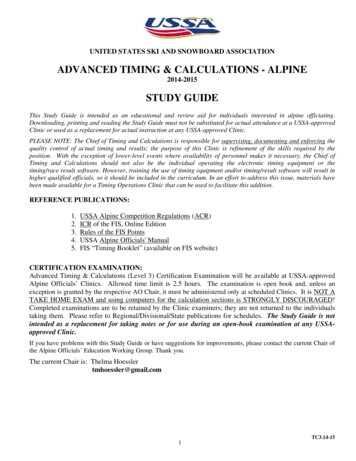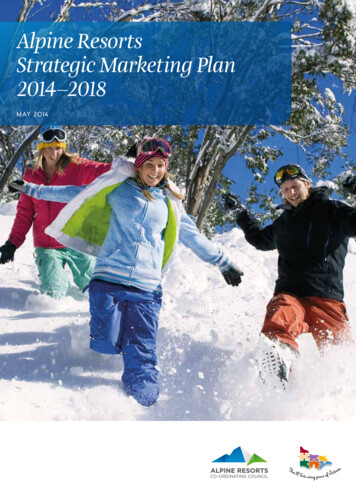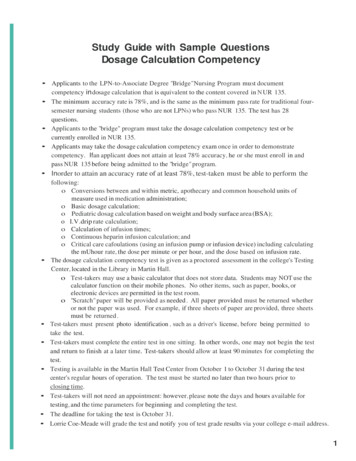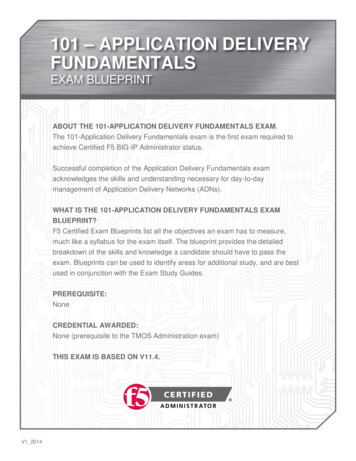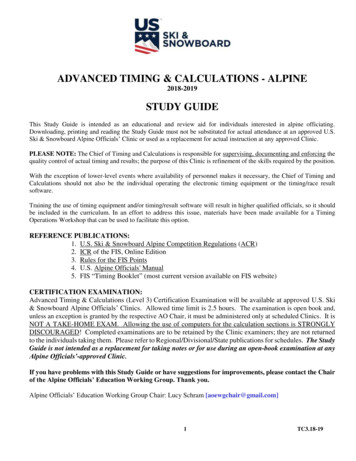
Transcription
ADVANCED TIMING & CALCULATIONS - ALPINE2018-2019STUDY GUIDEThis Study Guide is intended as an educational and review aid for individuals interested in alpine officiating.Downloading, printing and reading the Study Guide must not be substituted for actual attendance at an approved U.S.Ski & Snowboard Alpine Officials’ Clinic or used as a replacement for actual instruction at any approved Clinic.PLEASE NOTE: The Chief of Timing and Calculations is responsible for supervising, documenting and enforcing thequality control of actual timing and results; the purpose of this Clinic is refinement of the skills required by the position.With the exception of lower-level events where availability of personnel makes it necessary, the Chief of Timing andCalculations should not also be the individual operating the electronic timing equipment or the timing/race resultsoftware.Training the use of timing equipment and/or timing/result software will result in higher qualified officials, so it shouldbe included in the curriculum. In an effort to address this issue, materials have been made available for a TimingOperations Workshop that can be used to facilitate this option.REFERENCE PUBLICATIONS:1. U.S. Ski & Snowboard Alpine Competition Regulations (ACR)2. ICR of the FIS, Online Edition3. Rules for the FIS Points4. U.S. Alpine Officials' Manual5. FIS “Timing Booklet” (most current version available on FIS website)CERTIFICATION EXAMINATION:Advanced Timing & Calculations (Level 3) Certification Examination will be available at approved U.S. Ski& Snowboard Alpine Officials’ Clinics. Allowed time limit is 2.5 hours. The examination is open book and,unless an exception is granted by the respective AO Chair, it must be administered only at scheduled Clinics. It isNOT A TAKE-HOME EXAM. Allowing the use of computers for the calculation sections is STRONGLYDISCOURAGED! Completed examinations are to be retained by the Clinic examiners; they are not returnedto the individuals taking them. Please refer to Regional/Divisional/State publications for schedules. The StudyGuide is not intended as a replacement for taking notes or for use during an open-book examination at anyAlpine Officials’-approved Clinic.If you have problems with this Study Guide or have suggestions for improvements, please contact the Chairof the Alpine Officials’ Education Working Group. Thank you.Alpine Officials’ Education Working Group Chair: Lucy Schram [aoewgchair@gmail.com]1TC3.18-19
U.S. SKI & SNOWBOARDADVANCED TIMING & CALCULATIONS - ALPINE2018-2019There is much information available to us - no one can possibly know it all. What we SHOULD knowis WHERE to find it. Most of the sections of this Study Guide require research by the user. Thisresearch will aid in the ability to understand the layout of applicable rule books/publications and willreinforce their content.NOTE: The U.S. Ski & Snowboard Schedule Agreement and ACR U203.2, require that the Chief of Timing& Calculations be appropriately certified for their position; certification requires Alpine Official Membership.In addition, the Chief of Timing & Calculations for National Championship, Nor-Am Cup and World Cupevents should be certified as a Level 3 or higher Chief of Timing & Calculations.REFERENCE DOCUMENTS:The following reference items can be found at the end of this Study Guide, in “Miscellaneous Study GuideForms” or on the FIS website. Document numbering is not sequential because it agrees with numbering in the“Master Packet of Forms” (MPF) as posted on the U.S. Ski & Snowboard website. All forms contained in theMPF have been reviewed and, when required, have been updated for season 2018-2019. It is suggested thatforms be printed for easy reference while using the Study Guide.42.Timing ChecklistFIS List Cover Page (U.S./FIS websites)39.FIS Penalty Calculation FormFIS “Timing Booklet” (Misc. Study Guide Forms & FIS website)31.-33. Replacement Time (Hand) Time of Day (TOD) EET Simplified Example/FormI.Focus of this Study Guide is primarily FIS-level eventsA. Regional FISB. Nor-Am (Continental Cup)C. World Cup, World Championship and Olympic Winter GamesII.Characteristics of EventsA. Competitors are top level racersB. Team Captains are highly astute and knowledgeable professionalsDepending on type and level of event, 1 or 2 Team Captains may be appointed to serve asConnection Coaches. Connection Coaches: Serve as liaison between all Team Captains and the Jury Serve as on-hill “Eyes of the Jury” May supervise yellow flag zones in DH and SG Have voice but no vote in Jury matters/decisionsC. Organizing Committee (OC): Is highly experienced and qualified Is committed to a quality event Is aware media exposure can make any statement “news”2TC3.18-19
Is aware of financial commitment and need for sponsorsIncludes Technical Delegate as appointed by U.S. Ski & Snowboard or FIS Technical DelegateWorking Group representativeIncludes Referee, and Assistant Referee as appointed by the Technical Delegate (speed events)[601.2.3, 601.4]Includes Forerunners as appointed by the OCD. Race Jury World Cup: FIS Chief Race Director and FIS Race Director serve as Referee and AssistantReferee for all events – both speed and technical [601.2.1] World Championships and Olympic Winter Games: All Jury members, including Start andFinish Referee, are appointed by FIS and have voting rights [601.2.2, 601.4] In all other races* the Technical Delegate appoints the Referee and for Downhill and Super G,the Assistant Referee [601.2.3] By appointment, the above become members of the Organizing Committee [601.2.4]*Referee, Assistant Referee and Course Setters are appointed by Nor-Am Cup Committee for Nor-Am Cupevents. These officials may be appointed by U.S. Ski & Snowboard for Championship events.E. Additional support officials, as required, have a high level of certification, knowledge andexperienceF. Professional Timing Company and Timing System Requirements [611]G. FIS Computer Company1. FIS Pointsa. Validity [4.2.4 – the current season]b. Rule Observance [1.1 – rules not observed; race not scored]c. FIS List [5.1 – FIS List is only available electronically]d. FIS Points may only be corrected by FIS Bureau. FIS Points marked “C” on FIS websiteversion of FIS Points List are verified as being “confirmed”.e. FIS Base Points are calculations based on prior season’s results, have not been adjusted forthe next season (adders not yet applied) and are posted for informational purposes only.FIS Base Points must not be used for event seeding or penalty calculation purposes.2. Nor-Am Cup Points are used for seeding of the first group of fifteen (15). They are updatedafter each event. * (Due to greater number of athletes qualified for Europa Cup, differentprocedures apply for Europa Cup, e.g.: 30 in first group.)a. Entry to Nor-Am Cup events are quota controlled.b. Overall 400-point holders from prior season are seeded at 16th positionc. Overall 400-point holders who were injured and unable to utilize special seeding duringprevious season may use it at the first 3 races of the following season. This is valid for amaximum of 3 starts irrespective of the events.d. Effective Season 2019, athletes not already named as “Season 2018 Overall 400-pointholders” will have to earn 450 points to qualify for seeding at the 16th position3TC3.18-19
e. Overall 400/450-point holders are followed by entered competitors ranked within the top30 of the FIS Points List for the respective event.3. World Cup Points are used to seed first group of thirty (30); updated after each event. *a. Overall 500-point holders from among top 30 WCSL present are seeded at 16th positionb. Overall 500-point holders from remainder of field are seeded no later than 31st position* Refer to current Continental Cup Rules and World Cup Rules if more detail is required.III.What is SCORING?A. Dimensions of scoring are:To ensure that ALL scoring functions come together and function as a unit: Classic ICRdescriptions are found as follows: Chief of Timing & Calculations [601.3.6]1. Chief Timekeeper [612.4]2. Assistant Timekeepers (Manual/Hand Timekeepers) [612.5]3. Finish Controller [612.6]4. Chief of Calculation [612.7] (When appointed.)B. Scoring interacts with:1. Timing Company2. Scoring Computer Company3. Announcera. Announcer should be available to announce competitors’ unofficial times.b. Announcer should be available to announce DSQ’s. When an announcer is announcingunofficial times, DSQ competitor data announcement can replace posting of Report by theReferee. Team Captains must be notified beforehand if announcement of DSQ informationis going to replace actual posting. [617.2.2]4. Race Secretariat/Race AdministratorDue to requirements for preparation of accurate event documentation (these are all legaldocuments), it is strongly recommended that the Race Administrator not also assume the eventrelated duties and responsibilities of the Chief of Timing and Calculations.5. Press Chief6. Technical Delegatea. Verifies timely synchronization of timing equipmentb. Verifies accuracy of Official Results and Penaltyc. Verifies accuracy of data contained in “Timing & Data Technical Report Form” (TDTR)prior to its electronic transmission to FISd. Provides a signed PDF copy of transmitted TDTR for Race Administrator files (signed byboth Chief of Timing & Calculations and Technical Delegate)7. Referee (Report by the Referee).a. Chief of Timing or Assistant should track/enter NPS, DNS and DNF bib numbers on theReport by the Referee4TC3.18-19
b. Chief of Timing should meet with Referee (and Assistant Referee for speed events) andassist with entering DSQ competitor data, e.g.: Name, team, name of Gate Judge, type offault and either gate # where fault occurred or rule number applicable to infraction.8. NPS – Not Permitted to Start [627, 627.2, 627.6]: A competitor will not be permitted to start(NPS) in any FIS competition who does not wear a crash helmet that conforms to theSpecifications for Competition Equipment [606.4] or does not have ski brakes on their skis[606.3], does not wear or carry an official start number according to the rules [606.1]. An“official start number” refers to any bib issued by the local event organizer; this includesreplacement bibs furnished by the Start Referee.9. Recording “NPS” Situation - U.S. and FIS Eventsa. Due to rule(s) violation(s), athlete is not permitted to start; this could apply to either run ofa 2-run event and must be noted on the Start Referee’s Report; Jury must be advised.b. Software will include “NPS” designationc. If the old Report by the Referee is being used, athletes who are not permitted to start (NPS)should be clearly noted on the Report by the Referee.d. If new Report by the Referee posted on the U.S. Ski & Snowboard website in the MPF isbeing used, the athlete’s status is recorded in NPS section; bib #, name, club/nation andreason (in “Note” section).e. If the new Report by the Referee posted on the FIS website is being used, a section is onlyprovided for documenting bib #’s for NPS athletes.f. Technical Delegate must verify accuracy of Official Results and Penalty posted on U.S.Ski & Snowboard/FIS websites.NOTE: Due to force majeure, the Technical Delegate may prepare, sign and post the Report by the Refereeor may assign this duty to another official. A Report by the Referee signed by the Technical Delegate ordesignee is valid.10. Jury [601.4.6-601.4.7]a. In cases of system malfunctions, e.g. timing systems, Jury allows provisional rerunsb. In cases of doubt, Jury allows provisional reruns not based on system malfunctionsc. In cases of doubt, Jury allows provisional startsd. Confirms validity of provisional starts and provisional rerunse. Establishes start intervals for GS, SG, and DH and communicates the intervals(fixed/regular) to Chief of Timing or assistant.f. In cooperation with Chief of Timing or assistant, establishes start intervals for Slalom (nonfixed/irregular)g. In accordance with rules regarding minimum start intervals, establishes start intervals forGiant Slalom, Super G, Downhill Training and Downhillh. Confirms start intervals for Giant Slalom, Super G and Downhill and communicates anychanges with Chief of Timing or assistant11. Provides instruction to manual/hand timekeeping crew in order to provide required manualtimekeeping that is consistent and accurateC. QUALITY - Establish confidence in "Real Time" timing/scoring presentations1. Familiarize yourself with available timing systems: Start, Finish, Net Time5TC3.18-19
2. Verify scoreboard is available with: Bib #’s, Names, Unofficial Times3. Verify location of intermediate timing points4. Verify location and accuracy of video displays5. Furnish progress reports to media with respect for deadlines6. Document NPS, DNS and DNF on Report by the Referee and be available to verify NPS andDSQ competitor data, e.g.: Bib, Name, Team, Rule #7. Aid in preparation of accurate official reports according to formatIV.Initial Actions of Scoring are:A. Establish presence with the following:1. Secretariat: Verify Race Administrator is using updatedcurrent/applicable Points List(s) and confirmed technical data, etc.raceresultsoftware,2. Timing Company: Verify use of homologated timing equipment3. Scoring Computer Operations: Verify scoring software has been updated and is compatiblewith race result software4. Chief of Manual/Hand Timing: Verify availability of supplies, equipment and knowledge ofprocedures5. Technical Delegatea. Confirm timely synchronization of timekeeping equipment: electronic & manualb. Prepare Timing & Data Technical Report (TDTR) for Technical Delegate’sreview/signaturec. Oversee electronic transmission of Timing & Data Technical Report to FISd. Provide consistency and accuracye. Be available to verify all official timesB. Facilities and Schedules1. Verify schedule for Team Captains' Meeting2.Verify schedule for creating seed board3.Verify location of Press Room and identify press room liaison personnel4.Verify location and availability of results reproduction facilities5.Inspect Finish Building and Finish Line/Finish Area [615.2]a. Finish Photocells: Are they homologated?b. Width between Finish Posts1.) DH and SG finish line dimensions – no less than approximately 15 m*2.) SL and GS finish line dimensions – no less than approximately 10 m*3.) Line is marked horizontally with a coloring substance so that it is clearly visible to theapproaching competitor4.) Timing equipment/competitor security installation*Distance is between finish posts/banners not length of finish line. Timing posts mustalso adhere to these measurements.6TC3.18-19
6.Start Area, Start Facilities and Start Gate/Area specifications [FIS “Timing Booklet 2.54”]a. Homologated Start Gatesb. Dimensions1.) Width: Support posts should be 50 – 80 cm apart2.) Wand should be mounted approximately 35 – 50 cm from the snowc. Start Wand Installation1.) Description: small diameter fiberglass rod2.) Mountinga.) Only one wand is permittedb.) Wand cannot be so stiff that it could cause injury or not break, but must be stiffenough to eliminate false startsc.) Wand must stay open once it is triggered; auto return wands are not permittedd.) Duplicate start wand must be on hand for replacement purposese.) Mounted horizontally above the starting line and at an elevation that places it at orbelow a racer’s kneesf.) Mounted on a hinge. As the racer propels forward across the starting line, thewand is forced to swing forward and to the side by the racer’s leg. Placement ofstart gate must be marked on the support posts.g.) Replacement must be with identical gate, at same position and with same rotationh.) If two start gates are used in concert, they must be solidly mounted on samephysical bracket. Both mechanisms and box must be stiffly connected together.NOTE: Refer to current FIS Timing Guide for information regarding angular range and accuracy ofthe start wand.3.) Starting Gatea.) Minimum of 2 electrically isolated contacts activated by 1 wand.b.) Timing wires must be connected to separate start gate contacts using separateconnections.c.) Wand must be installed so that starting is impossible without it opening.d.) Exact replacement gate must be available, if required4.) Communicationa.) Wiring between the start wand and the timekeeper’s booth is generally availablethrough another pair or wires or is piggybacked onto an existing pair – usuallybackup.b.) A headset may be plugged into a jack at the start so that the Starter can be inconstant voice communication with the timing room7. Accompany Jury on course inspection and check for the following:a. Location of “yellow flag” zones and “blind” areas. FIS is reviewing language regardingyellow flag zones. Possible change may include Giant Slalom as an event requiring use ofyellow flags. At this time, requiring designation of yellow flag zones for Giant Slalom isa Jury decision.b.Staffing and location of timekeeping assistants (manual/hand)7TC3.18-19
c.V.Staffing and location of intermediate timing positions, if availableQuestions You Need to Ask:A. Are all entries in? Are all entries on the Board? (This is important for DHT where rules requirethat all qualified competitors be entered and drawn in all training runs.)B. What computer-scoring program is being used and has it been updated? Is the operatorfamiliar/comfortable with its use?C. Does it meet the requirements of 611.3.5, which requires that computer software that calculates nettimes must use precision of ToD as used in the timing device?D. Is the correct and current Points List available?E. Is the scoring computer up to date on entries?F. Have all the preliminary reports been prepared?G. What is preparation status of timing facilities? (Refer to #42. Timing Checklist)H. Has all of the required header data been entered in the race file?I. What timing equipment is being used? Is the operator familiar/comfortable with its use?J. What system will be used to transfer data between results computer and timing1. Transfer of race file which does not allow the RA to perform race data editing during race2. Transfer of timing file which involves only bib numbers, competitors’ names and times doesallow for race data editing3. Verify transfer process been established and tested: email, cloud, thumb drive or runnerK. What start gate is being used?L. What finish photocells are being used? Photo Finish timing has been approved for use at FIS eventsfor backup purposes only. FIS has established criteria for photo finish systems, and they must befollowed (see current edition of FIS “Timing Booklet”). Due to the cost of the equipment, it willmostly be used at OWG, WSC, WC levels.M. Are timing equipment, start gates and finish photo cells on the current homologated lists? [611.2]NOTE: All timekeeping equipment MUST meet stipulated standards. Use of equipment that does not meetstandards will result in an event not being considered (scored).N. Are requirements for electronic data transmission of Official Results and Penalty – wireless ornetwork – in place?It may seem that we are delving into areas of responsibility belonging to other officials; however, it isnecessary to be sure that all interfaces have been established, tested and should function smoothly andefficiently. There is not enough time to try to establish or fix procedures while the competition is in operation.The Chief of Timing & Calculations or Scoring – in cooperation with other officials – should evaluate theseinterfaces and take whatever action is necessary to get the job done without sacrificing QUALITY!8TC3.18-19
VI.Quality Assurance ActionsA. Team Captains’ Meeting, Seeding and the Draw. According to National and FIS rules, the drawmust be conducted (or confirmed) at a Team Captains' Meeting. An actual meeting, attended inperson by Team Captains, Jury, and race officials is an inseparable and mandatory part of thecompetition and is important for communication of Jury instructions, support of the OC, as wellas conveying OC requests and information. It is also a critical element for risk management andliability-related matters. [Refer to 621.8, 604.3]With the approval of the Jury and at a time and place announced to all Team Captains, and wherea computer-assisted Draw has been approved or is not required (e.g. YSL where TRS by class andgender is used to determine the start order), an informational meeting is still required but may beheld either immediately after the completion of a race for the next day's event or on the morningprior to a race.For all Team Captains’ Meetings for all U.S.-sanctioned events—both scored and non-scored, andregardless of where and when they occur, an Attendance List must be available and signed byeveryone attending the meeting. Meeting Minutes must be generated and must be included in thesubmitted race result packet.1. Keep in close touch with Secretariat2.Attend Team Captains' meetings3.Review the Seed Board before and after Drawa. Verify accuracy of the Boardb. Verify seed-point ties are identifiedc. Verify correct seeding of competitors entitled to 16th/31st position, if applicable (U.S.“Golden Rule”, FIS Nor-Am Cup & FIS World Cup)d. Verify grouping of competitors without pointse. Verify additional special seeding groups as authorized by the Jury4.Verify correct application of rule regarding “Snow Seed”?5.Verify number of available Forerunners6.Independently record the Draw7.Recheck the Start or Training List against the Boarda. Verify header information against the appropriate source: Homologation fileb. Verify accuracy of footer informationNOTE: USE OF ELECTRONIC SEED BOARDS: Electronic seed boards must have the capability tosimultaneously and legibly display the entire competition field. Simultaneous display of all competitors allowsall Team Captains and officials to verify the overall accuracy as well as additions and deletions to the startingorder in “real time”. Using the race result software to display portions of the competition field is notacceptable.B. Downhill Training1. Verify all timing equipment and personnel will be in place for all training runs2.Verify accuracy of Start List in scoring computer3.Address intermediate timing considerationsIt is best to co-ordinate with the Technical Delegate and the Jury for placement of intermediate9TC3.18-19
timing equipment. When wiring for an intermediate, confirm that the momentary switch getswired into the signal side of the wire, not the ground side. To avoid the cells being triggeredby anyone other than the competitors, it is recommended that the person responsible forintermediate timing points use a push-button to arm the photocells when a competitor crossesthe line.a. Timing machine operatorsb. Necessity of having on-hill operators4.Multiple Time Basesa. Verify that score board, either electronic or paper, is available to display competitors’timesb. Verify that forerunners' times will not be displayedc. Verify accuracy of Time-of-Day printoutsd. Verify status of press room video displays, if availablee. Verify status of Announcer's display, if available5.Press Reports (UNOFFICIAL) Standard format not requireda. Establish contact with Chief of Pressb. Establish system for press report production and distribution1.) Verify accuracy of documents released to press2.) Keep copy of all documents released to press3.) Cooperate with electronic transmission to Press Room if no runner is available6.Other ReportsAccurately prepare all required reports in a timely mannerC. Race Day - Be prepared for the unexpected.1. First Runa. If possible, attend Jury inspectionb. Verify schedule1.) A run or race that is rescheduled for a later time slot on the same day is delayed2.) A run or race that is rescheduled to a different date within the series is postponed3.) A run or race that is started but cannot be completed is terminated. There is no setnumber that has to start or finish. If even one forerunner has started and the Jurydetermines that the event cannot continue, it is a “terminated” event.4.) A run or race that cannot be rescheduled within the series is canceled*; cancellationof an event vacates the U.S. Ski & Snowboard race code/FIS codex and invalidatesthe event liability insurance.c. Verify amount of 2nd Run “Bibbo” [Reverse 15? 621.11.3]d. Verify synchronization checks with TD; assist with compilation of “Timing & DataTechnical Report”1.) Online filing required for all FIS events. The required program is currently availableat nd-data.html.It isavailable for Linux, MacOS and Windows, (XP is no longer supported); and programupdates will be posted on the website as required. Software will alert when anupdated version is available.10TC3.18-19
2.) Paper copy filing is required for all National events, both scored and non-scored. FISprogram can be used to produce a paper copy report, as required, for National nonFIS events. (When the software is used for a National event, presence of FIS logo isa non-issue.)The FIS program can be used to produce a paper copy report, as required, for Nationalnon-FIS events. The software will accept a “National Race Code” (alpha character 4-digit number); “Race Codex” is left blank and either “CHI – Children”, “CIT –Citizen” or “JUN – Junior” category must be selected. The XML file must not besubmitted to FIS for non-FIS events or to U.S. Ski & Snowboard as the NationalOffice is not currently set up to accept the timing report XML file.e. Verify course and weather data for headers and communicate the information to RaceAdministrationf. Follow preparations of timing and computer operationsg. Verify instructions for manual/hand timekeeping crewh. Verify measurement by wheel, tape or GPS for DH and SG has been accomplishedi. Recheck start order in computerj. Plan press report production; follow plank. Keep "Report by the Referee" up to date by noting bib #’s for NPS, DNS and DNFcompetitorsl. Observe timing company operations1.) Verify accuracy of time-of-day printout2.) Verify accuracy of interval timing reports prior to distribution3.) Make notes on Start List; especially important for documenting anomalies4.) Track differential between main and backup timing5.) Identify five best (lowest) point holders who start race regardless of resultm. Print unofficial listing immediately after last competitor finishesn. Meet Jury at finish with complete unofficial listing and “Report by the Referee"1.) Assist Referee/Assistant Referee with review of Gate Judge Cards2.) Provide a copy of unofficial competitors’ ranking for the Technical Delegate3.) Deliver DSQ list to announcero. Publish Unofficial Results reportp. After protest period verify appropriate action taken on DSQ's with computer operationsand/or Race Administratorq. Print/verify 2nd Run Start List or 1st Run Resultsr. Verify Race Administrator has been made aware of any Jury decisions that may requiredocumentation (Jury Minutes), e.g. application of snow hardening agents, change in startorder, change in start times, change in announced start intervals for Giant Slalom, SuperG, Downhill Training and Downhills. Although not necessarily part of your responsibilities, notify Race Administrator of anyincidents that may require filing of injury reports11TC3.18-19
2. For Second Run of Two-Run Eventsa. Assist with completion of “Timing & Data Technical Report”b. Verify 2nd Run cutoffsc. Verify accuracy of Second Run Start List. [6.21.11]1.) “Bibbo”; check for ties at last position of flipped group (30th or 15th)2.) Verify start order of ties outside of “bibbo”3.) For scored non-FIS events, verify if 1st DNF/DSQ competitors are included on 2ndRun Start Lista.) Suggested Procedure for Tracking 1st Run DNS, NPS, DNF, DSQ athletes in2nd Run:The Chief of Timing & Calculations and the Race Administrator/Data Manageraccount for all competitors, and the National Technical Delegate Report requiresdocumentation of these calculations. For events where 1st-run DNS, NPS, DNF,DSQ athletes are allowed to start in the 2nd run, this can create a uniquechallenge. Some Technical Delegates may instruct the Chief of Timing &Calculations to stop recording after all valid 2nd-run starters have completedtheir run. This will result in an incomplete record of the event, so the followingis suggested as an alternative procedure.- Start Referee notifies Timing when last valid 2nd-run starter has left the start- Chief of Timing & Calculations or assistant makes appropriate notations inthe DNS and DNF sections of the Report by the Referee- Report by the Referee will now concisely reflect how many actual 2nd-runDNS and DNF competitors are to be considered in calculation of“Finishers/Total Ranked on Result”.The following is suggested method. Chief of Timing or assistant may userecording method of their choice; e.g.: End 2nd Run, Run 1 Racers, etc.d. Complete additional duties performed during 1st rune. If time permits, complete hand calculation of Penalty and include calculation draft whenmeeting with Technical Delegate after race.12TC3.18-19
VII.Update and Review Items Relevant to Timing & CalculationsA. Factors: DH - 1250 SL - 730 GS - 1010 SG - 1190 AC – 1360P – 870B. Timing & Data Technical Report Requirement Change: A Timing and Data Technical Reportis required for all levels of U.S. Ski & Snowboard events – both non-scored and scored. Use ofthe FIS TDTR software is strongly encouraged.The Chief of Timing & Calculations is responsible for submitting a copy of the TDTR to therespective TWG reviewer; calculation(s) required for Replacement Time(s) (EET) mustaccompany the TDTR.C. Start Clocks and Audible Start Commands [U613.4]: U613.4 has been added to the ACR inorder to clarify the use of a start clock does not replace audible (spoken) start commands.D. Timing at Start & Finish: U611.25 has been amended to allow use of transmitters at start andfinish for non-scored ev
This Study Guide is intended as an educational and review aid for individuals interested in alpine officiating. Downloading, printing and reading the Study Guide must not be substituted for actual attendance at an approved U.S. . 3 TC3.18-19 Is aware of financial commitment and need for sponsors Includes Technical Delegate as .
